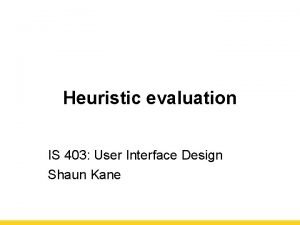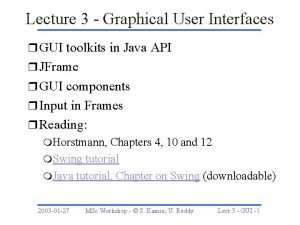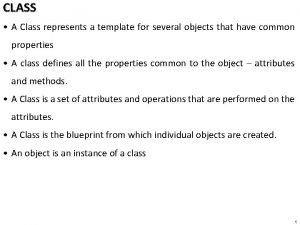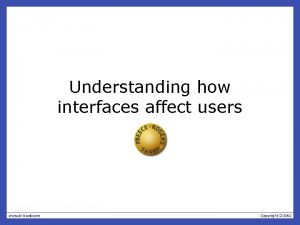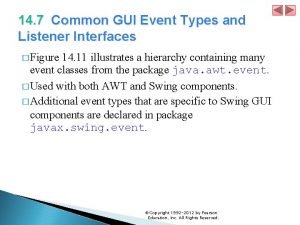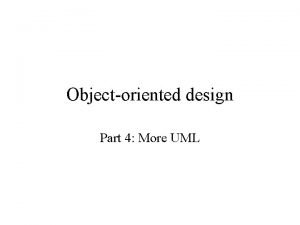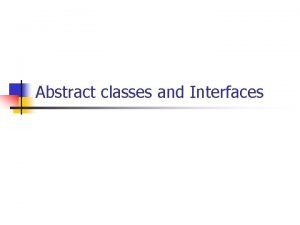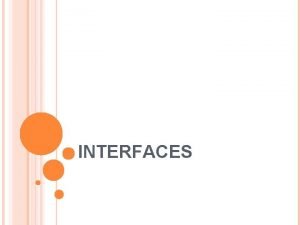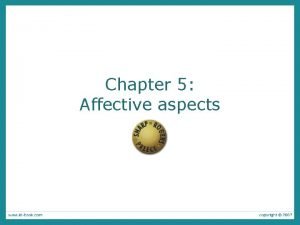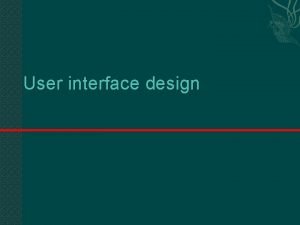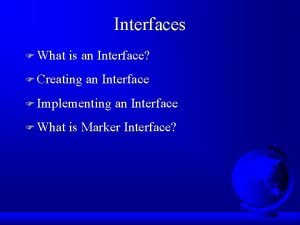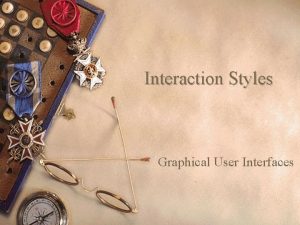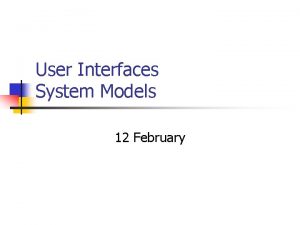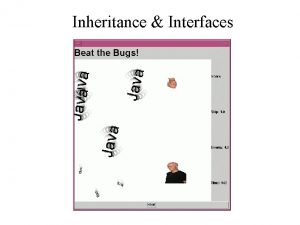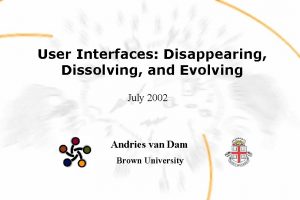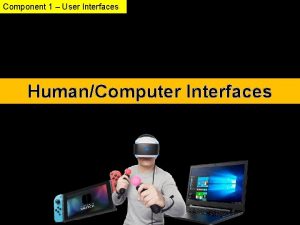Interactively Evolving User Interfaces Juan Quiroz Committee Dr













































- Slides: 45

Interactively Evolving User Interfaces Juan Quiroz Committee: Dr. Sushil Louis Dr. Sergiu Dascalu Dr. Swatee Naik

Outline • • Motivation Related work: GAs, IGAs, UI Design User fatigue in IGAs UI evolution Experiments Results Future Work

Motivation • User interface design is a complex, expensive, time consuming process • Iterative process • Users and contexts of use are numerous • Streamline and improve UI design • End-user customization

IGA for UI Evolution • IGA to explore the space of UIs – Creativity and insight • Evolution is guided by both the user preferences and coded guideline metrics • Pick best and worst

Genetic Algorithms • Population based search technique – Natural selection – Survival of the fittest

Interactive Genetic Algorithms (IGAs) • Fashion design (Kim 2000) • Micromachine design (Kamalian 2005) • Music, editorial design (Takagi 2001) • Traveling salesman problem (Louis 1999)

User Evaluation: Subjective Fitness 100 75 15 20 8 80 53 82 38

User Evaluation: Ranking 1 5 6 3 2 9 8 7 4

User Evaluation: Tournaments A B Fitness A > Fitness B

User Fatigue in IGAs • GAs tend to rely on: – Large populations – Many generations • Suboptimal solutions • Noisy fitness landscapes

Alleviating User Fatigue • Use small population sizes • Display a subset of population • Accelerate convergence through prediction (Llora 2005) Just what I had in mind!

UI Design Support • GUI toolkits and libraries

Guidelines of Style • Microsoft, Apple, Java, KDE, Gnome • Define a common look and feel for applications • Discuss the use of color, layout of widgets, the use of fonts • Interpreting the guidelines is itself a challenge – Too vague or too specific

Ambiguity in Guidelines “Use color to enhance the visual impact of your widgets” – Apple’s Human Interface Guidelines

XUL User Interfaces • XML User Interface Language • Mark-up language for UIs – Buttons, textboxes, sliders menubars, toolbars

Related Work: UI Evolution • Evolution of style sheets (Monmarché et al) – Font and links color, paragraph spacing, font family, font decoration • We allow both the user and the coded guidelines to guide the evolution

Related Work: User Fatigue • SVMs to combat user fatigue (Llora 2005) • Kamalian et al. (2005) – User evaluation every tth generation – Demote or promote reaction to individuals – Validity constraint is used to determine viable and meaningful designs

Interactive Genetic Algorithms in UI Design

Lagoon Move. To Panel

UI Representation • Two chromosomes – Widget chromosome – Layout chromosome

Genetic Operators for UI IGA • Single point crossover • Bit flip mutation • PMX – partial mapped crossover • Swap mutation

Widget Color • RGB color model – Red = (255, 0, 0), Green = (0, 255, 0), Blue = (0, 0, 255) • 224 color space for each widget • HSV – Same gamut as RGB – No significant efficiency difference in RGB and HSV

Fitness Evaluation 1. Ask the user to select the best and worst UIs from the subset displayed 2. Interpolate the subjective fitness of individuals in population 3. Compute the objective metrics taken from guidelines of style 4. Fitness = w 1 * subjective + w 2 * objective

1: Fitness Evaluation Best Worst

2: Subjective Fitness Interpolation Best • Compare to best • Compare to worst Worst

3. Objective Fitness Computation • High contrast between widget colors and background color • Low contrast between widget colors

Fitness = w 1 * subjective fitness + w 2 * objective fitness

Research Questions • Which selection type is the most effective for this problem? • Who from the population do we display for user evaluation? • How often should we ask for user input?

Experimental Setup • Greedy simulated user • 30 independent runs, 200 generations • Population size of 100 • Roulette wheel vs. tournament • Display method comparison: best 10, random 10, best 5 and worst 5 • User input every 1, 5, 10, 20, 40, 80 generations

Which selection type is the most effective for this problem?

Who from the population do we display for user evaluation? Fitness Convergence to Blue UIs

How often do we ask for user input? User input every tth generation Fitness convergence Low values of t High values of t

How often do we ask for user input? User input every tth generation Convergence to blue UIs Low values of t High values of t

Experimental Setup: Actual Users • Three users • 30 generations • Pick the one they like the best and the one they like the least • 5 sessions – User input every 1, 3, 5, 10, 15 generations – 30, 10, 6, 3, and 2 user evaluations respectively

Results

What leads to the drop in average performance? • Two sessions with a user – Comparison to user selected worst turned on – Comparison to user selected worst turned off • Always pick the same UI as the best • Ask for user input every 3 generations

What leads to the drop in average performance?

Generated UIs: Simulated User

Generated UIs: Simulated User

Generated UIs: User 3

Generated UIs: User 3

Future Work • Ask user to select the best/worst UI only • Varying the frequency of user input during a session • Convergence acceleration with neuroevolution or SVMs • Integration with a GUI toolkit or library • User studies! – Task completion • Explore color representations • Specify the type of data that needs to be represented

Contributions • We can use IGAs to evolve UIs • Our simulated user and actual users are able to effectively bias the evolution of UIs • UIs reflect coded guidelines of style • Reduce user fatigue – Interpolation technique – Asking for less user input

Demo

Questions? • www. cse. unr. edu/~quiroz • quiroz@cse. unr. edu
 Web user interfaces
Web user interfaces User interfaces design dc
User interfaces design dc Why are user interfaces hard to implement
Why are user interfaces hard to implement Heuristic evaluation of user interfaces
Heuristic evaluation of user interfaces Gui for r
Gui for r Marina quiroz geriatra
Marina quiroz geriatra Issste fernando quiroz
Issste fernando quiroz Que se pone en una autobiografía
Que se pone en una autobiografía Atanasio quiroz
Atanasio quiroz Key evolving signature
Key evolving signature Evolving
Evolving Evolving design
Evolving design A framework for clustering evolving data streams
A framework for clustering evolving data streams Single user and multi user operating system
Single user and multi user operating system Types of operating systems
Types of operating systems Juan juan studio melina
Juan juan studio melina What is difference between abstract class and interface
What is difference between abstract class and interface 2g architecture with interfaces
2g architecture with interfaces Ieee srs standard
Ieee srs standard Blueprint interfaces
Blueprint interfaces Expressive interfaces
Expressive interfaces Interfaces inteligentes
Interfaces inteligentes Contextual tools
Contextual tools Surface phenomena and colloidal system
Surface phenomena and colloidal system Difference between abstract classes and interfaces
Difference between abstract classes and interfaces Communication interface in embedded systems
Communication interface in embedded systems Team interfaces
Team interfaces Gui event types in java
Gui event types in java Uml interfaces are used to:
Uml interfaces are used to: Abstract classes in java
Abstract classes in java Ss um
Ss um Interfaces are syntactically similar to
Interfaces are syntactically similar to Expressive interfaces
Expressive interfaces Micros e interfaces
Micros e interfaces Which is not an objective of designing interfaces?
Which is not an objective of designing interfaces? Industrial interfaces
Industrial interfaces What is interface
What is interface Expressive interfaces
Expressive interfaces Ims architecture with interfaces
Ims architecture with interfaces Dialogues
Dialogues Mdi ui
Mdi ui Property management system interface
Property management system interface The dance committee hired a dj for the fall dance
The dance committee hired a dj for the fall dance Consultative committee for space data systems
Consultative committee for space data systems Infection control committee
Infection control committee Aci 544
Aci 544



